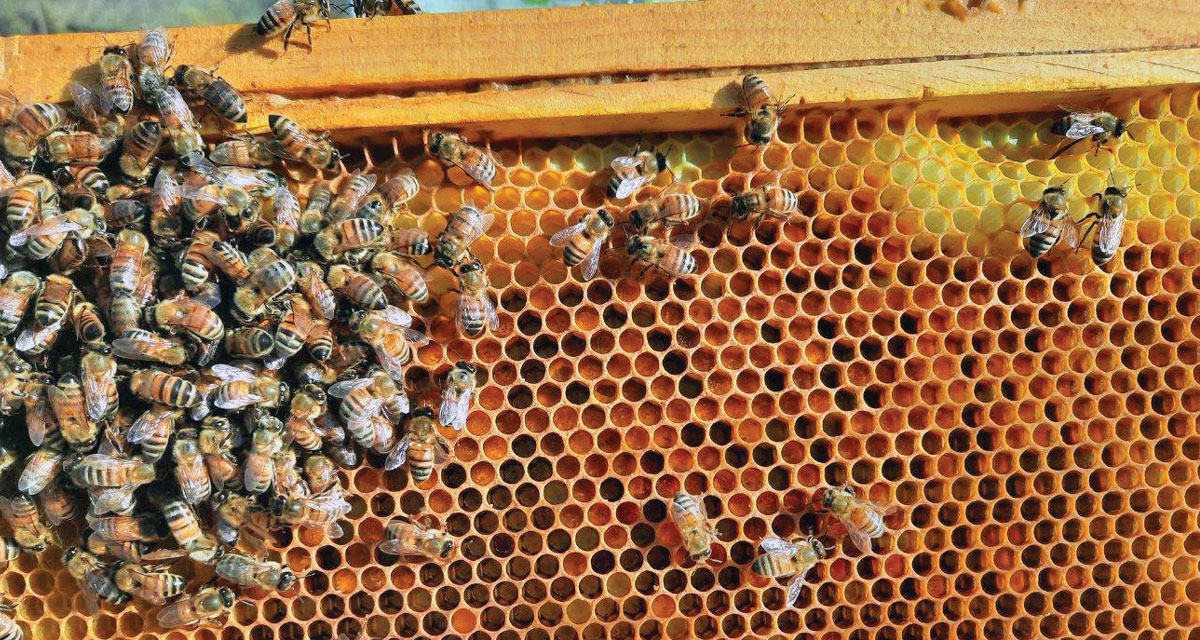“Go to the bee, thou poet: consider her ways and be wise.” ~ George Bernard Shaw
Sitting on the front porch stoop on a summer evening, you can see hundreds of forager bees showing a visible pattern of flight, zipping to and from the apiary’s entrance. It looks like geometric lines filling the sky. Their industry never ceases—all for the goal of building up stores of honey to survive the winter. For millions of years, bees have endured challenging conditions and climates. And, yet, with a beekeeper looking in periodically to assess the hive’s health, the apiary can be much stronger entering into a season of cold. Like most creatures, honeybees begin their winter preparation from August through to October.
Clean the House
Not every hive check requires an intrusive look into every box and frame. If you remove the top cover, the layer of protection is a quilt box made from wood and wire. Beekeepers can smell the hive and know it’s well. If you look down upon the thousands of tiny, mobile golden bodies, you will notice each one has a particular job within the colony.
- All the workers are female, living between four and six weeks. They clean, moving the dead, adding “propolis”—a sticky glue-like substance to seal cracks—and force the drones, the males, out before winter. In addition, workers collect matured nectar from forager bees, place it in cells, transform it into honey, and seal the capping.
- Nurse bees comfort, protect, clean, and feed the queen bee while she lays 1500 to 2000 eggs per day. Without the queen, the colony would collapse and die.
- A mature worker bee can transition to guard and protect the entrance from intruders, such as bears, mice, or wasps; however, on cold nights, the guard will freeze and die.
- The most challenging job is performed by the forager bee. acquired at the end of its life. They leave the hive to pollinate one-third of the food we eat.
Eliminating the Bad Pests
Honeybees need human assistance to defeat the infestation of a deadly predator—the parasitic Varroa mite. It preys only upon honeybees by lodging on the bees’ back, crippling it until death, or entering the brood, where developing larvae will hatch. The Ukrainian-designed propane fogger is one instrument of prevention, which uses a long probe to shoot seconds worth of oxalic acid, mixed with 190-proof alcohol, into the opening of each hive. After three treatments, one per week, the mite-free hive has a remarkable chance to thrive! Fogging occurs in the early spring and late summer.
Thermal Bees Arrive
Honeybees are miraculous creatures! They self-regulate the interior temperature in summer and winter. Bees engage in an act called fanning, where the insects will face one direction fluttering their wings to move air in or out.
As nights become cooler and the pollen levels drop, the queen bee begins laying the winter brood. She is a specialized honeybee that aids the colony’s survival through to spring. Numbers within the hive will have significantly dropped; as the bees bond together to form a tight, ball-shaped cluster, the winter bee inserts her enlarged abdomen into the comb and radiates heat, ensuring warmth.
Feeding the Bees
By October, the colony is ready to embark on the most challenging season. Each apiary has had an intrusive check to ensure the honey stores were enough to satisfy the bees, and a feeder was added, providing extra nourishment. Honey boxes, light in weight, are often extracted from the tower. The bees need limited space and smaller areas to heat. Quilt boxes, empty all summer, receive handfuls of cedar chips as a means of breathable insulation. Adding the top cover, all beekeepers can do is pray, and await warm days when the bees take off from the bottom board and fly!























